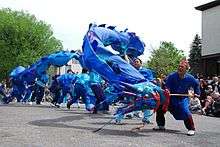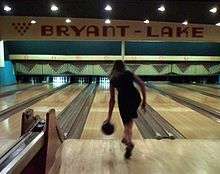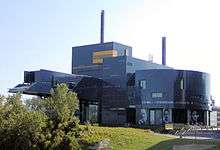Culture of Minnesota
The culture of Minnesota is a subculture of the United States with influences from Scandinavian Americans, Irish Americans, German Americans, Native Americans, Czechoslovak Americans, along with numerous other immigrant groups. They work in the context of the cold agricultural and mining state.
People

Stereotypical Minnesotan traits include manners known as Minnesota nice with very strong family ties and a sense of community exclusive to those with shared beliefs. Potlucks, usually with a variety of tater tots, are popular at community functions, especially church activities. Movies such as Fargo, Grumpy Old Men, Drop Dead Gorgeous, the television series Fargo (loosely inspired by the film), the radio show A Prairie Home Companion, and the book How to Talk Minnesotan describe Minnesotan culture, speech, and mannerisms.
The Minnesota State Fair, advertised as The Great Minnesota Get-Together, is an icon of state culture. In a state of 5.5 million people, there were nearly 2.0 million visitors to the fair in 2017.[1] The fair covers the variety of life in Minnesota, including fine art, science, agriculture, food preparation, 4-H displays, music, the midway, and corporate merchandising. It is known for its displays of seed art, butter sculptures of dairy princesses, and the birthing barn. On a smaller scale, these attractions are also offered at the state's many county fairs.
Other large annual festivals include the Saint Paul Winter Carnival, the Minneapolis Aquatennial, Lakes Jam, the Mill City Music Festival, and Detroit Lakes' 10,000 Lakes Festival and WE Fest, and Moondance Jam & Jammin' Country, both held every summer in Walker.
Cuisine

Some common wild edibles include wild rice, serviceberry, chokecherry, blueberry, raspberry, blackberry, thimbleberry, and hazelnuts. A variety of fish, such as trout and walleye, are available in the multitude of state lakes. Many of these foods have long been staples of Native communities prior to the Industrial Revolution and before white settlement in the region. The Ojibwe, for example, consider wild rice not only to be an important foodstuff but an "object of veneration, and an important ingredient of social and ceremonial life."[2]

With an increase in immigration from abroad, Minnesota's culture appropriated traditions from its parent Scandinavian and German heritages, adopting traditional cuisine items such as lefse, lutefisk, rosettes, gravlax, krumkake, lingonberries, kransekake, sausages, and sauerkraut. Minnesota is also known for what is known in the state as "hot dish", a type of casserole, and "jello salads".
The relatively short growing season demanded agricultural innovation. The Minnesota Agricultural Experiment Station's Horticultural Research Center at the University of Minnesota developed three new apple varieties, the Haralson, Honeycrisp, and very recently the Sweetango. These fare well in the harsh Minnesota climate and produce popular fruit.
At the Minnesota State Fair dozens of foods are offered "on a stick", such as Pronto Pups and deep fried candy bars. Although not actually typical Minnesota Cuisine, these are archetypal fair foods. Minnesota is also home to several beers including Hamm's Brewery, Summit Brewing Company, Surly Brewing Company, and August Schell Brewing Company, which also produces Grain Belt.
Sports and recreation

Sports in Minnesota include professional teams in all major sports, Olympic Games contenders and medalists, especially in the Winter Olympics, collegiate teams in major and small-school conferences and associations, and active amateur teams and individual sports. The state of Minnesota has a team in all four major professional leagues (MLB, NFL, NBA, and NHL); the University of Minnesota is one of the founding members of the oldest major college athletic conference still running, the Big Ten.
Minnesota's warm summers provide its natives and tourists with a variety of outdoor activities, though it is mostly known for its winters. Many Minnesotans embrace winter. The state has produced curlers and skiers who have competed in the Winter Olympics, pioneers who invented the snowmobile, Rollerblades, water skiing and legions of ice fishing enthusiasts.[3] The state is also known for enthusiastic ice hockey players, both at the amateur and professional levels. Eveleth, Minnesota, home to the United States Hockey Hall of Fame, boasts of the number of quality players and the contributions of the city (and the rest of the Mesabi Range) to the growth and development of hockey in the United States.[4] The abundance of both indoor and outdoor ice rinks in the state provides ample opportunities for learning and practicing several winter sports, which in turn produces accomplished athletes in those sports.
Minnesota's more than ten thousand lakes naturally play an important role in the state's recreation patterns. Minnesota has the highest per-capita boat registration figure of any state in the country.[5]
Arts
Music

The music of Minnesota has played a role in the historical and cultural development of Minnesota. The state's music scene centers on the Minneapolis-Saint Paul area, and most of the Minnesotan artists who have become nationally popular either came from that area or debuted there. Rural Minnesota has also produced a flourishing folk music scene, with a long tradition of traditional Swedish, Finnish and Norwegian music.[6] Minnesota's modern local music scene is home to thousands of local bands, many of which perform with some regularity.[7] Some performers from nearby regions of neighboring states, such as western Wisconsin and Fargo, North Dakota, are often considered a part of the Minnesota music scene.
Minneapolis has produced a number of famous performers, such as Bob Dylan, who, though born in Duluth and raised in Hibbing, began his musical career in the Minneapolis area, and Jimmy Jam and Terry Lewis, who eventually formed The Time and produced for Gladys Knight and Janet Jackson. Minneapolis' most influential contributions to American popular music began in the 1970s and 1980s, when the city's music scene "expanded the state's cultural identity" and launched the careers of acclaimed performers like the multi-platinum soul singer Prince, and cult favorites The Replacements and Hüsker Dü. More recently, the Twin Cities has played a role in the national hip-hop scene with record labels Rhymesayers Entertainment and Kamorra Entertainment, and artists such as Atmosphere, Brother Ali, P.O.S and Manny Phesto.[8] Other musicians of many genres have been popular, including harmony singers The Andrews Sisters, the alternative rock group Semisonic, Owl City, and the cult favorites Motion City Soundtrack.[9]
Fine arts

The Minneapolis-Saint Paul metropolitan area is considered to be the arts capital of the Upper Midwest. Its major fine art museums include the Minneapolis Institute of Art, the Walker Art Center, and the Frederick R. Weisman Art Museum. The Minnesota Orchestra and the Saint Paul Chamber Orchestra are prominent full-time professional musical ensembles that perform concerts and offer educational programs to the community. Attendance at theatrical, musical, and comedy events in the area is strong, which may be attributed to the cold winters, the large population of post-secondary students, and a generally vibrant economy. The nationally renowned Guthrie Theater moved into a new building in 2006, boasting three stages and overlooking the Mississippi River. In the United States, the number of theatre seats per capita in Minneapolis-Saint Paul ranks behind only New York City; in 2000, 2.3 million theatre tickets were sold.[10] The Minnesota Fringe Festival is an annual celebration of theatre, dance, improvisation, puppetry, kids' shows, visual art, and musicals. The summer festival consists of over 800 performances in 11 days, and is the largest non-juried performing arts festival in the United States.[11] The Children's Theatre Company, Minneapolis, and the SteppingStone Theatre for Youth Development, Saint Paul, are leading youth theaters.
The Public Radio program A Prairie Home Companion, hosted by Minnesota native Garrison Keillor aired live for many years from the Fitzgerald Theater in Saint Paul. The show ended its run in 2016, with its successor Live from Here also airing from the same venue.
Weather
.jpg)
Minnesota's climate has done much to shape the image and culture of the state. Minnesotans boast of their "theater of seasons", with a late but intense spring, a summer of water sports, a fall of brilliantly colored leaves in the state's parks and hardwood forests, and a long winter made bearable by outdoor sports and recreation.
"Summer at the lake" is a Minnesota tradition. Water skiing was invented in Minnesota by Ralph Samuelson, and the Minneapolis Aquatennial features a milk carton boat race. Contestants build boats from milk cartons and float them on Minneapolis area lakes, with recognition based more on colorful and imaginative designs than on actual racing performance.[12]
To many outsiders, Minnesota's winters appear to be cold and inhospitable. Even among Minnesotans (and more generally upper mid-westerners and some Canadians), a common expression is that there are only two seasons, Winter and Road Construction. This is due to long winters that damage road surfaces, and short summers in which a frenzy of repair work causes severe congestion.[13] A World War II newscaster, in describing the brutally cold conditions of the Russian front, stated that at least Minnesotans could understand it.[3] A New York journalist visited St. Paul and declared that the city was "another Siberia, unfit for human habitation." In response, the city decided to build a huge ice palace in 1886, similar to one that Montreal had built in 1885. They hired the architects of the Canadian ice palace to design one for St. Paul, and built a palace 106 feet (32.3 m) high with ice blocks cut from a nearby lake.[12] This began the tradition of the Saint Paul Winter Carnival, which spawned a legend with a mythical king, "King Boreas". Each winter, King Boreas declares a ten-day celebration with feasting, fun, and frolic, along with the "Queen of the Snows" and singer "Klondike Kate". Ice sculptures are featured, and periodically ice palaces are built; one was the setting of St. Paul native F. Scott Fitzgerald's story The Ice Palace, published in Flappers and Philosophers. On the tenth day of the festival, "Vulcanus Rex", the King of Fire, storms the castle with his Vulcan Krewe, compelling Boreas to relinquish winter's hold on the land until he returns again.[14]
Tourism
Tourism has become an important industry, especially in the northern lakes region. In the North Country, what had been an industrial area focused on mining and logging has largely been transformed into a vacation destination. Popular interest in the environment and environmentalism, added to traditional interests in hunting and fishing, has attracted a large urban audience within driving range.[15] The memory of the great logging industry is exemplified by local folklore.[16]
Popular culture
On the TV series Beverly Hills, 90210, twins Brandon and Brenda Walsh were transplants from Minneapolis.[17] The character of Marshall Eriksen from the sitcom How I Met Your Mother is a proud Minnesota native from St. Cloud with some episodes taking place there. The main characters of Nickelodeon's Big Time Rush are branded as "four hockey players from Minnesota." American Idol held auditions for its sixth season in Minneapolis in 2006[18] and Last Comic Standing held auditions for its fifth season in Minneapolis in 2007.[19] The winner of season 4 was Josh Blue, a St. Paul native. The actor winning the role of "Sandy" on the televised Grease: You're the One that I Want! competition was Laura Osnes, an Eagan native; she played Sandy in the 2007 Broadway run of Grease. A statue of Mary Tyler Moore downtown on the Nicollet Mall commemorates the 1970s television situation comedy Mary Tyler Moore, awarded 3 Golden Globes and 31 Emmy Awards.[20]
Minnesota's winters are the setting of several Hollywood films, including the comedies of Grumpy Old Men (1993) and Grumpier Old Men (1995), set in Wabasha, but filmed in St. Paul.[21][22] The Coen Brothers' 1996 dark comedy film Fargo, along with its 2014 spin-off series, also feature the backdrop of a Minnesota winter. The film primarily takes place in Minneapolis and Brainerd, with Bemidji and Duluth serving as the main settings for the TV show. Characters are depicted speaking with a strong, over-the-top Minnesota accent.[23] Another Coen Brothers' film, 2009's A Serious Man is filmed and set in their hometown of St. Louis Park with the leading protagonist being a professor at St. Olaf College.[24]
Fandom
The Minneapolis-Saint Paul metropolitan area is the long-standing home of several fandom organizations such as SF Minnesota, MISFITS, and Mnstf who annually hold Diversicon, CONvergence, and Minicon, respectively. These are each large gatherings of fans interested in science, speculative, and fantasy fiction; panels are held where authors, publishers, and scientists interact with readers, viewers, and fans of filk music with the goal of increasing enlightenment of the topics discussed.
References
- "Minnesota State Fair". Minnesota State Fair. Retrieved 2018-01-24.
- "A Fight to Save the Tradition of Wild Rice - Culture". Retrieved 2004-10-13.
- Lass, William E. (1998) [1977]. Minnesota: A History (2nd ed.). New York, NY: W.W. Norton & Company. ISBN 0-393-04628-1.
- "U.S. Hockey Hall of Fame". Retrieved 2007-02-04.
- "Boat & Water Safety: Minnesota DNR". Retrieved 2007-12-10.
- Garland, pp. 866 - 881
- Music Scene.org An incomplete listing of local bands at MusicScene.org has 2,241 entries as of February 2005, while a concert calendar compiled by the University of Minnesota's radio station usually lists dozens of performances each week in the Twin Cities
- Minneapolis Music Collection In the mid-1970s and early 1980s, the creative explosion in Minnesota's thriving black and white rock music scenes expanded the state's cultural identity far beyond the shores of Lake Wobegon.
- Breining, Greg (December 2005). Compass American Guides: Minnesota, 3rd Edition (3rd ed.). Compass American Guides. ISBN 1-4000-1484-0.
- "Gopher Express". Coffman Info Desk. Regents of the University of Minnesota. 2006-10-12. Archived from the original on 2007-08-19. Retrieved 2006-10-24.
- "How to fringe". Fresh Art Delivered Daily. Minnesota Fringe Festival. 2006. Archived from the original on 2006-11-14. Retrieved 2006-11-22.
- Dregni, Eric; Mark Moran; Mark Sceurman (2006). Weird Minnesota. New York, NY: Sterling Publishing. ISBN 1-4027-3908-7.
- "News for Minnesota Department of Transportation Employees: Variety". Minnesota Department of Transportation. Retrieved 2008-07-10.
- "Winter Carnival: History". St. Paul Winter Carnival. Archived from the original on 2007-01-29. Retrieved 2007-02-04.
- Aaron Shapiro, The Lure of the North Woods: Cultivating Tourism in the Upper Midwest (University of Minnesota Press, 2015).
- John Patrick Harty, Legendary Landscapes: A Cultural Geography of the Paul Bunyan and Blue Ox Phenomena of the Northwoods (ProQuest, 2007)
- Sparling, David A., Internet Movie Database (n.d.). "Plot summary for "Beverly Hills, 90210"". Retrieved 2007-03-14.CS1 maint: multiple names: authors list (link)
- Gary Levin, USA TODAY (July 10, 2006). "Idol tryouts begin Aug. 8". USA Today. Retrieved 2007-03-14.
- "NBC's "Last Comic Standing" Live Tour". North Shore Music Theatre. Archived from the original on 2007-07-15. Retrieved 2007-05-15.
- Meet Minneapolis (2007). "Mary Tyler Moore statue". Archived from the original on 2007-04-20. Retrieved 2007-03-21.and Internet Movie Database (2007). "Awards for "Mary Tyler Moore" (1970)". Retrieved 2007-03-14.
- "Filming Locations for Grumpy Old Men". Internet Movie Database. Retrieved 2007-02-11.
- "Filming Locations for Grumpier Old Men". Internet Movie Database. Retrieved 2007-02-11.
- "Review of Fargo". New York Times. Retrieved 2007-02-11.
- Campbell, Tim (2007-09-28). "Coen brothers to get 'Serious' in Minnesota". Minneapolis Star Tribune. Minneapolis, MN. Archived from the original on 2009-11-03. Retrieved 2010-09-07.